What is the difference between letterboxing and geocaching?
Short Answer: Both are outdoor, public treasure hunts, with a slight distinction.
Geocaching uses coordinates on a GPS (global positioning system) to locate a waterproof container called a cache.
Letterboxing uses a series of clues and sometimes a compass to find the letterbox.
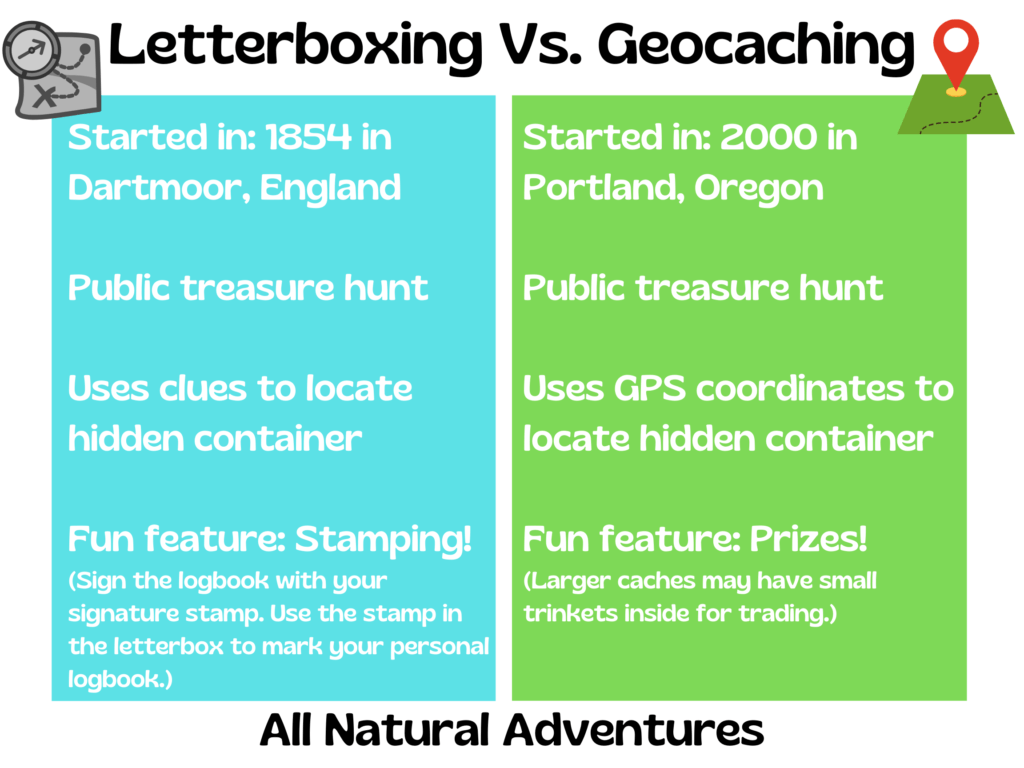
Let’s dive deeper and compare letterboxing vs. geocaching to discover all the similarities and differences between these fun, adventure sports!
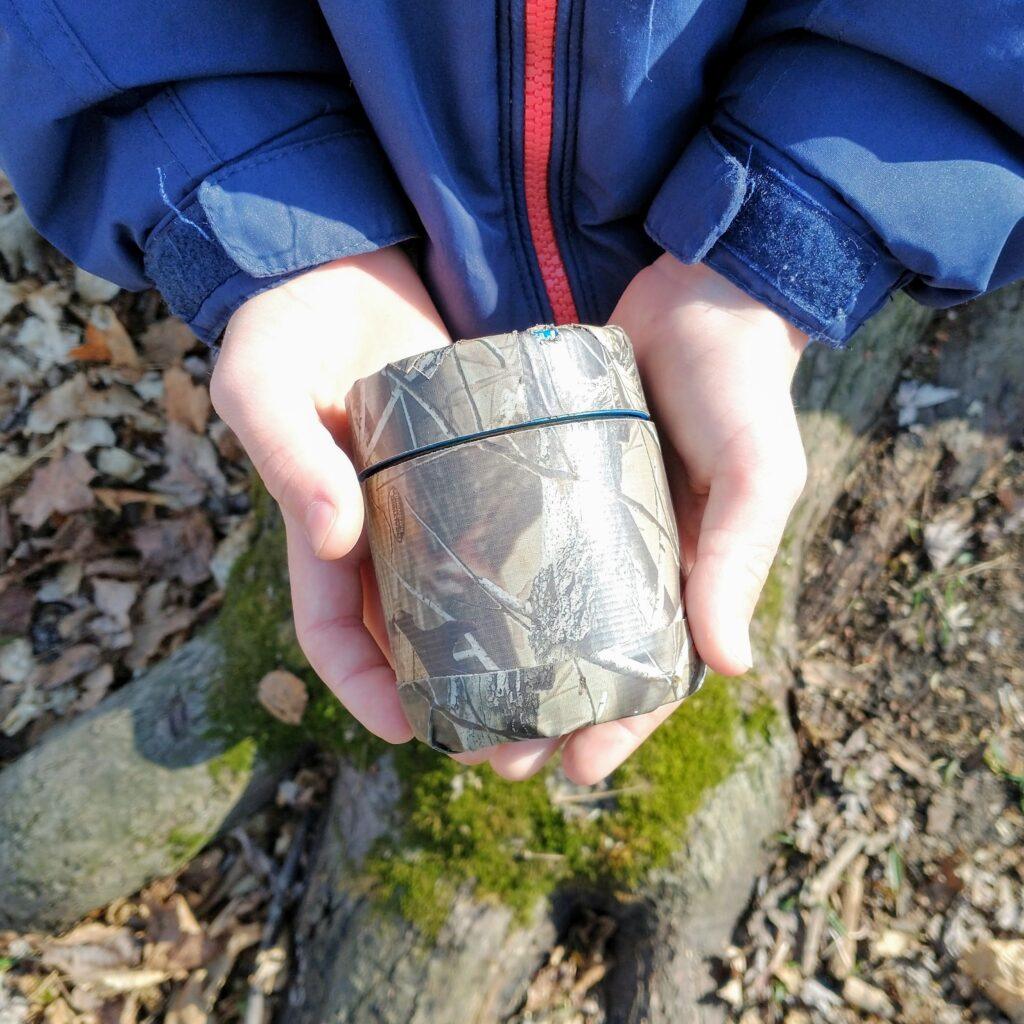
Letterboxing Basics
Letterboxes are hidden in public places like parks and nature trails and can be located by following clues from the letterbox owner. Most letterbox seekers use online forums to review the clues for local letterboxes, although some boxes are only discovered through word of mouth clues.
Example of a Letterboxing Clue: "Take the next left turn, go to the tree with the trunk like a big sleeping bear. Look towards the pavilion, spy the tree like a “V” and you will find it behind there."
The actual letterbox can be any type of durable container that can withstand the elements, such as a metal canister or plastic kitchenware.
A fun feature of letterboxing (and a distinction from geocaching) is the stamping element. Part of letterboxing involves choosing or creating your own signature stamp that you carry along with you, plus your own ink pad, on your treasure hunting adventure.
When you find a letterbox, there will be a logbook and a stamp inside. In the logbook, you can sign with your trailname and signature stamp. Then, you can use the letterbox stamp to mark your own personal logbook to track all of the letterboxes you have found.
This stamping aspect is a huge hit with kids!
Going letterboxing with kids? Check out Letterboxing With Kids: 7 Tips For An Awesome Adventure.
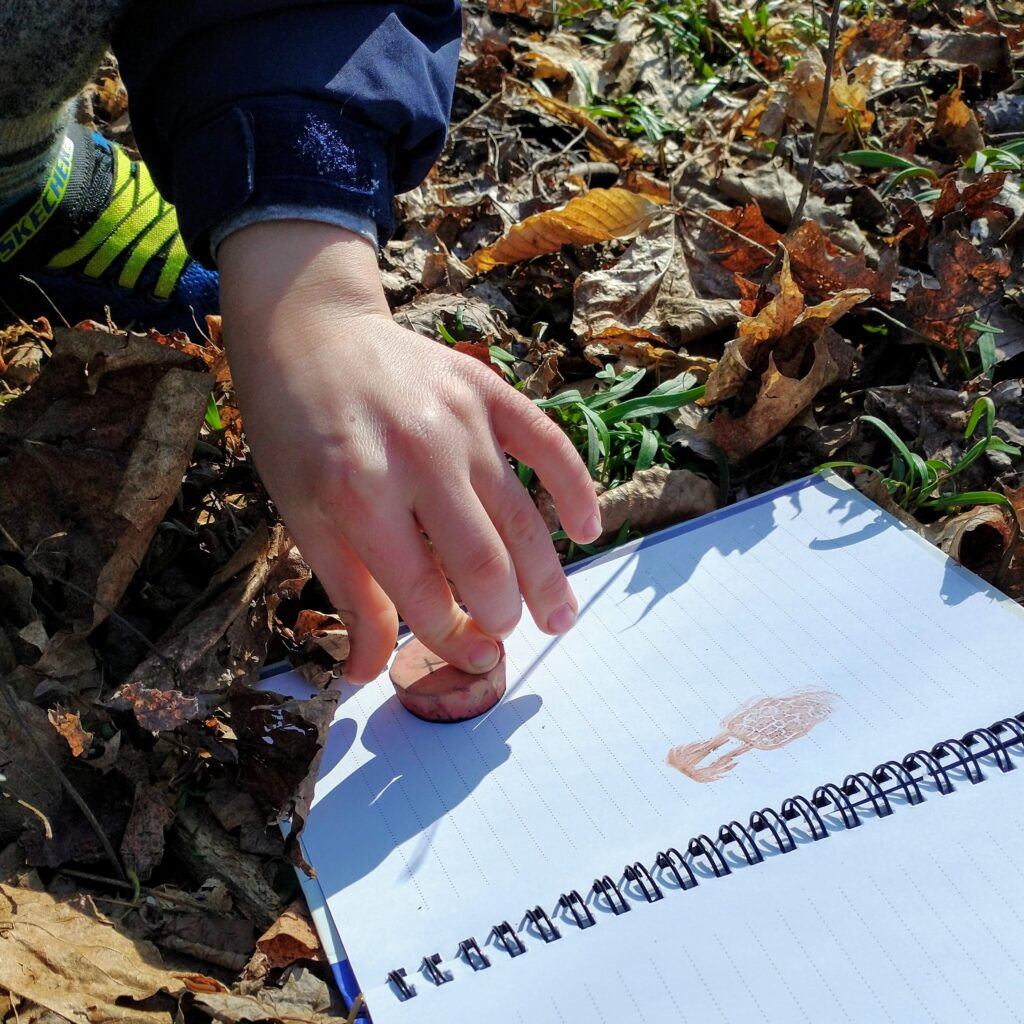
Letterboxing Legacy
Ready to nerd out a little on history?
The sport of letterboxing is over 165 years old! In 1854, adventurer James Perrot hid a bottle along a rugged, remote hiking trail in Dartmoor, England. In the bottle Perrot left his calling card (similar to a modern business card) and encouraged other avid adventurers to leave their own calling cards.
Thus, the treasure hunting sport of letterboxing was born.
Over the years, calling cards evolved into logbooks and stamps to mark the find.
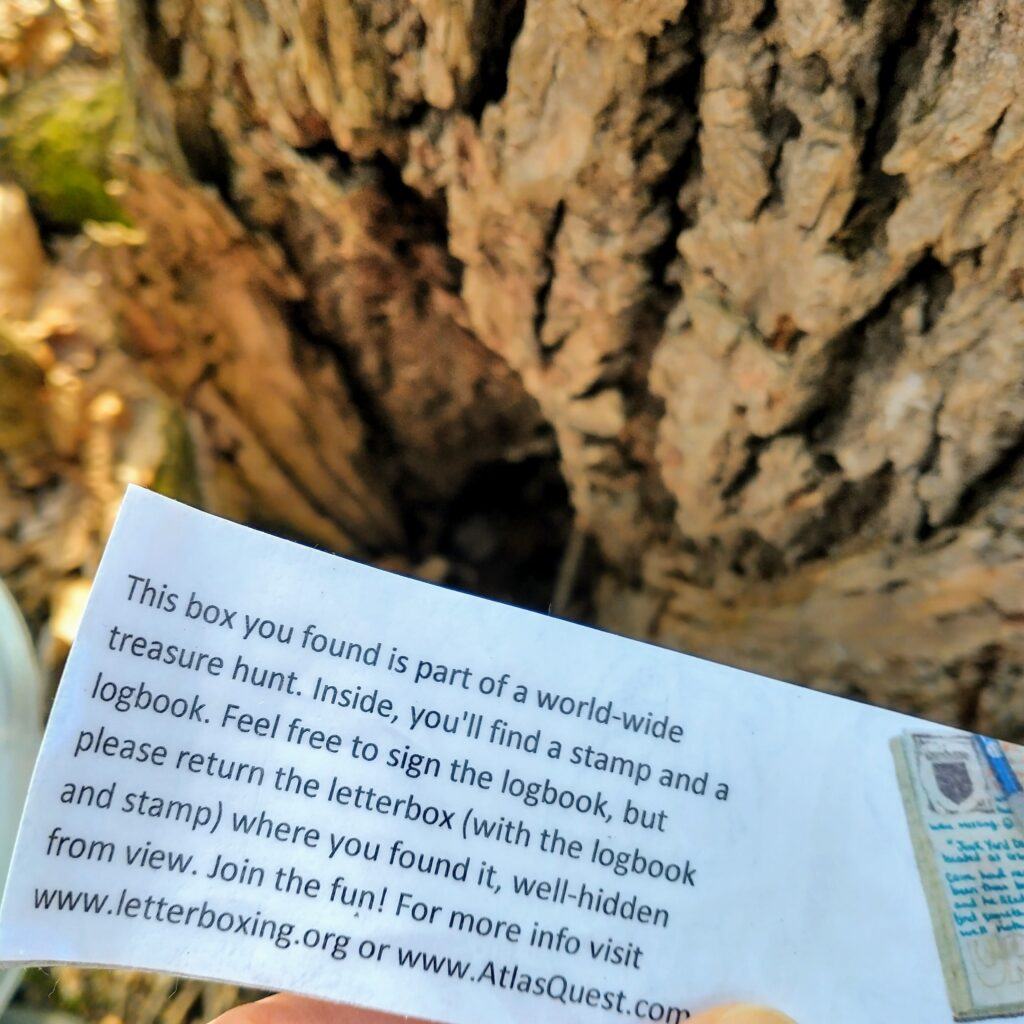
How to Find Local Letterboxes
To find a local letterbox, check out the online forums at letterboxing.org and atlasquest.com. Simply search by your location to see how many letterboxes are close by.
Each listing will show the letterbox owner, the park or location address, and the clues that go along with finding the letterbox.
Also listed are the date the letterbox was first planted and the date it was the last found. Since letterboxes are outdoors in public spaces, they can get moved or lost. Look for letterboxes that have a more recent find date to avoid disappointment!
Geocaching Basics
The overall premise of geocaching is the same as letterboxing – find a hidden container, or in this case a cache, in a public space like a park. The major difference is you will enter the exact coordinates or waypoint into a GPS device or a smart phone with GPS technology to locate the cache.
Some geocache descriptions will also provide helpful hints to help find the cache. Often the hints will have to be decoded first.
The fun part of geocaching, especially with kids, is the potential prizes that can be inside the caches. Along with a logbook for signing, little toys or trinkets for kids or even money might be included as treasure. If you take a prize from the cache, the honor code of geocaching requires that you leave something else inside for the next treasure hunter to find.
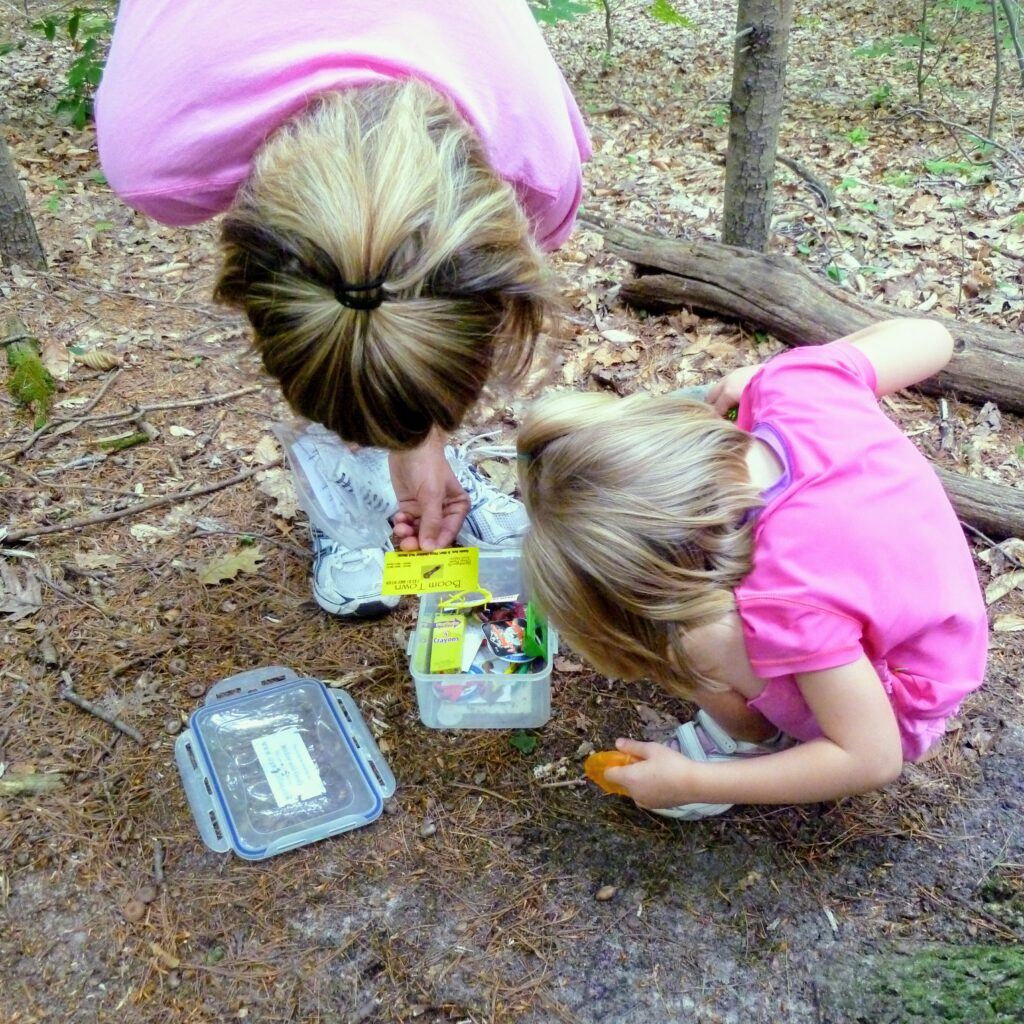
Geocaching History
Geocaching is a much newer hobby than letterboxing, and came about through advances in satellite and GPS technology. In 2000, computer consultant David Ulmer hid the first “stash” in the woods near Portland, Oregon and posted the waypoint in an online GPS users community.
Later, the term geocache was coined. Geo means of the earth and cache means a hiding place.
Through media coverage in magazine and newspaper articles, the sport of geocaching quickly gained steam. Today it is a global phenomenon enjoyed by treasure hunters of all ages with millions of geocaches hidden worldwide.
How to Find Local Geocaches
Sounds fun! Now, to find a geocache, the most popular online forum is geocaching.com. On this site you will need to create a login to access geocache details. With a free account you can access all the basic information you need to geocache or you can upgrade to a paid account for advanced features.
A couple of helpful features listed in the online geocache description are the difficulty rating, terrain rating, and size of geocache. Also, make sure to check the logged visits section for updates on the caches status and possibly more hints to find it.
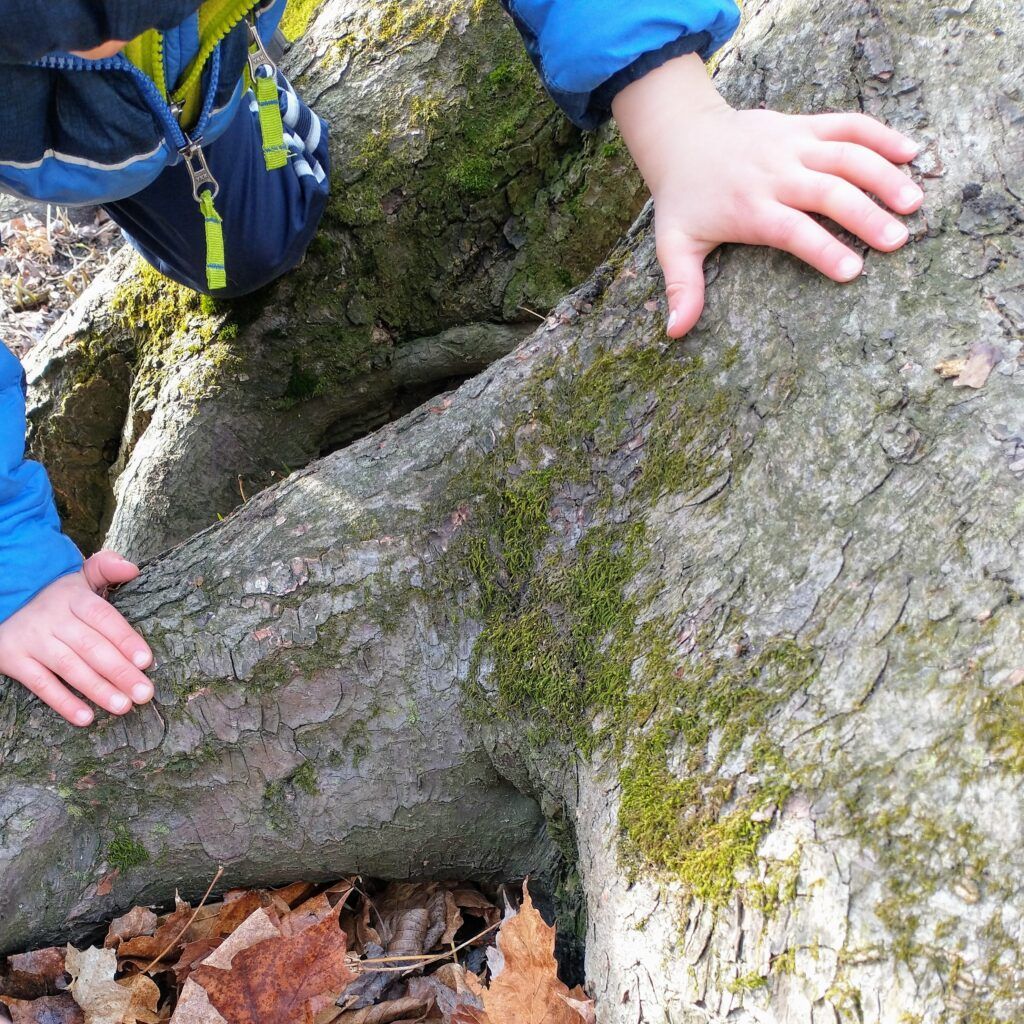
Types of Geocaches
Over the years, geocaching adventurists have taken the hobby even further by developing several types of geocaches.
- Traditional. The original geocache includes a hidden container at the given waypoint. Inside will be a logbook and possible prizes to trade.
- Multi-Cache. In a multi-cache, you will need to find two or more locations. The first waypoint will lead to the next and the container will be hidden at the last location.
- Mystery or Puzzle. This type often includes a detailed puzzle to first determine the coordinates. Also, it can encompass any unique cache that doesn’t fit into another category.
- EarthCache. An EarthCache is educational approach to geocaching rather than a physical cache. This involves learning about and answering questions related to an interesting geological location.
- Letterbox Hybrid. Some adventurers will hide a container as both a geocache and a letterbox. These containers will have a stamp to mark your personal letterboxing logbook. The best of both worlds!
- Wherigo Cache. This type of cache combines virtual video game adventures with real world geocaching. To play, a Wherigo toolset is required. Find out more at wherigo.com.
Travel Bugs
As a bonus, you might find a travel bug in a geocache! A travel bug is an object with a unique tag for tracking. Log your find online at geocaching.com and see if the travel bug has a specific travel goal. Some might be trying to make it as far as another country. On your next geocaching adventure, take the travel bug with you to place in a new cache location.
One West Michigan geocaching and letterboxing hot spot: Millennium Park (MI)
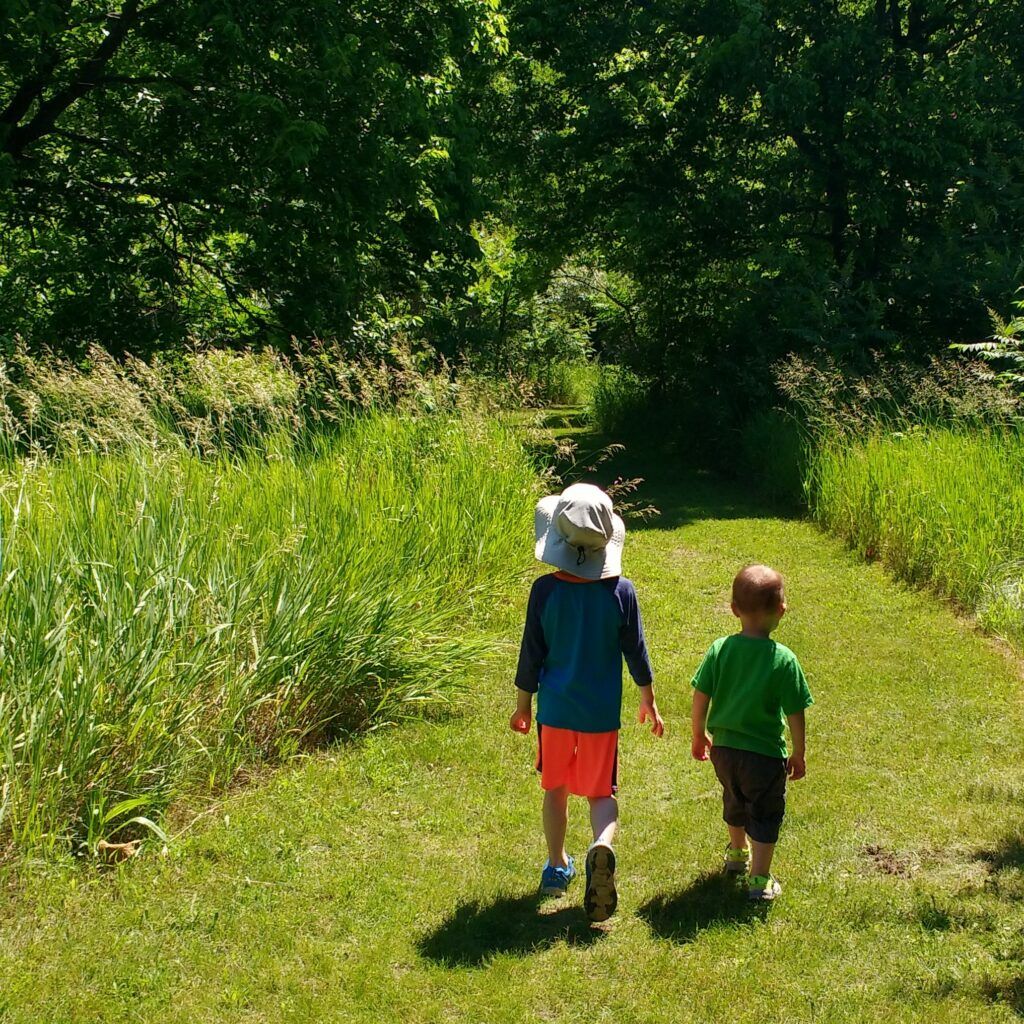
Geocaching & Letterboxing Etiquette
While participating in the fun of modern treasure hunting, there are a few etiquette guidelines to follow to keep these hobbies positive for the whole community.
Leave No Trace.
The basic principle of hiking also applies here – try to have no impact on the environment. This means being careful not to trample plant life or damage wildlife habitats while searching for a geocache or letterbox.
Also, take nothing with you and leave nothing behind. Whatever you bring in with you, bring it back out with you, especially food wrappers or other trash.
Keep It Secret.
Part of the fun of letterboxing and geocaching is the element of secrecy. Be discreet when searching. Curious muggles (or non-geocachers) may accidently remove or damage a cache not knowing its purpose.
Also, when you find a geocache or letterbox, make sure to hide it as well or better than you found it. This helps keep it safe for the next adventurer on the hunt.
Happy Treasure Hunting
I hope you enjoyed learning all about the similarities and differences of letterboxing vs. geocaching.
Are you new to letterboxing or geocaching or are you a pro? I’d love to hear your thoughts and experiences on these treasure hunting sports below!
Love family adventures? You may also enjoy:




I have never participated in an Letterbox adventure and must say that I find it intriguing. I can’t believe that it’s such an old sport! I have checked out the links you have provided and found a few hotpots close to my location. I am definitely going to try it out.
I have done an EarthCache before and it was fun although it was more in a formal setup.
I guess finding Pokemon is like a Wherigo cache?
I totally agree with you that the principle of “leave no trace” should apply in these adventures. After all one wants others to also enjoy nature and what it has to offer.
This was very informative, thanks for sharing the adventure.
So glad to hear you will be trying a letterboxing adventure! I was intrigued that it was such as old sport as well. Plus, it’s always to fun to find a new way to enjoy local parks.
Pokemon Go and Wherigo do seem very similar. I have not personally done either yet, but I could definitely see my kids getting into those variations in the future.
Definitely so important to protect our parks and natural areas!
What a great read. I am a keen geocacher and had never heard of letterboxing until I got into Geocaching. I had only read a little on letterboxing and believed it to be American, I had absolutely no idea that it had started in England (learn something every day).
I would urge anyone, especially those with kids to give them a try. If you need a reason to get out and about this is a good, fun and interesting one. Not only does it get you outside and exercising, but you can also learn so much and meet some very interesting people too.
We have discovered some beautiful areas that we would otherwise never have found through Geocaching.
Thanks again for the read.
Definitely a great way to have fun exploring the outdoors!
The history of letterboxing is so fascinating, isn’t it? I love participating in a sport that has been around for ages.
Pingback: bahis siteleri
Glad you enjoyed it! Hope you have some fun letterboxing and geocaching adventures ahead!
Letterboxing uses clues and more often than not, compass readings. They are in buildings but it started on Dartmoor in devon.The majority are hidden on the moor itself under boulders, on and around the Tors ( rock outcrops).
There are also travelling letterboxes and moving boxes. Travellers are carried by letterboxes and you can ask for them. Moving boxes are found inside other boxes. You take these with you to the next box you find.
There is also the letterbox meet and walks to collect a series of boxes.